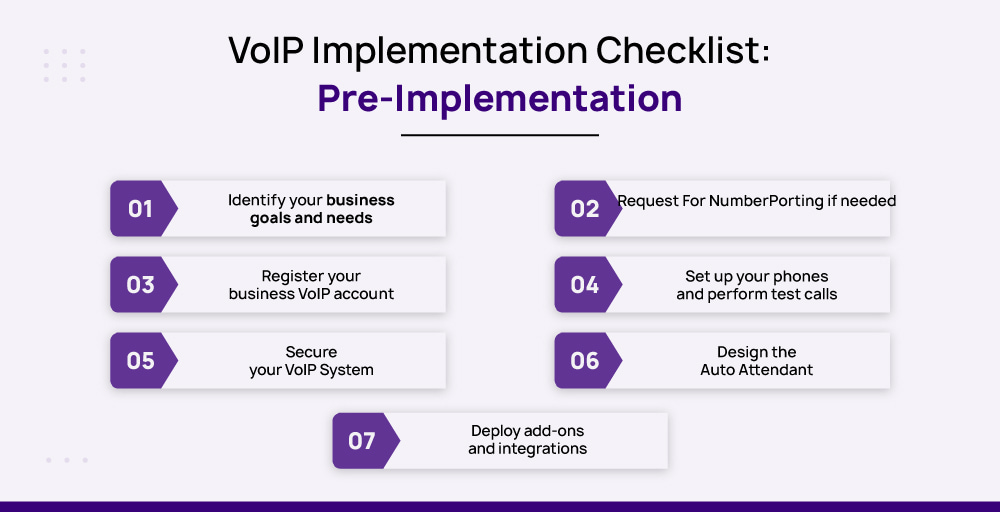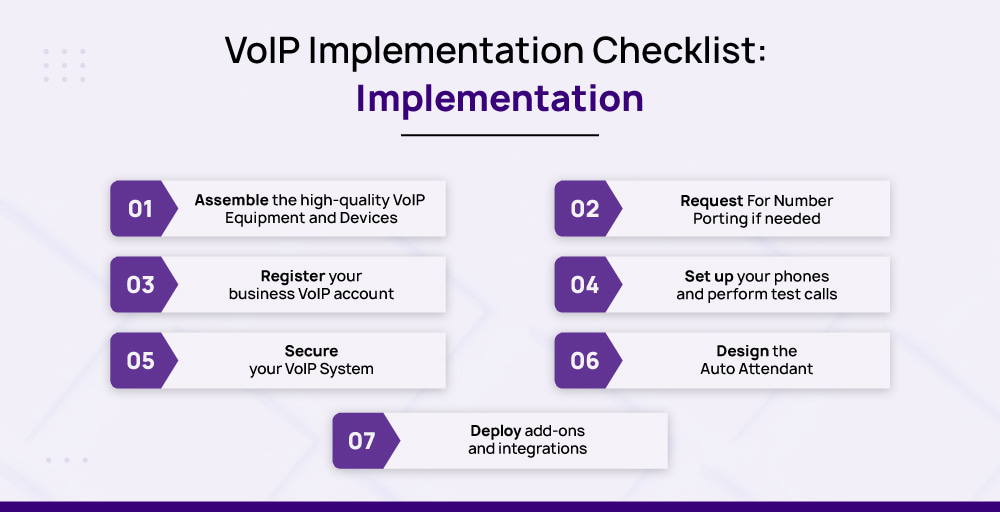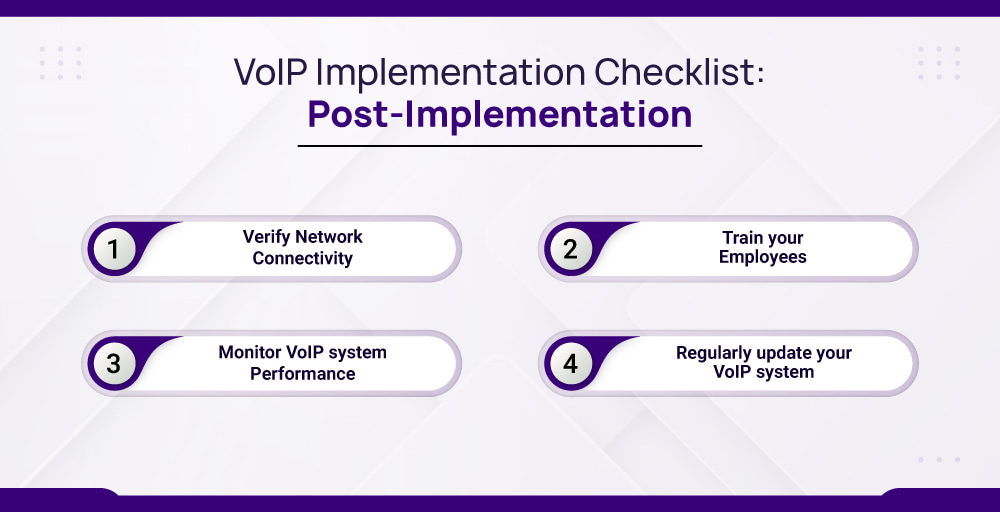VoIP has emerged as a cost-effective and efficient solution for businesses looking to improve their communication systems and is thus rapidly replacing traditional phone systems.
However, using it without appropriate planning might be disastrous. 🤔
Hence, a question arises- how to implement a VoIP service effectively?
Worry not; we’ve got a solution to help you throughout the process and execute a seamless transition.
In this article, we aim to explain the importance of a VoIP implementation checklist ✅, how it works, and describe the whole implementation process in a step-by-step manner.
Now, let’s get started! 👊
What is the VoIP Implementation Checklist?
A VoIP Implementation Checklist is a step-by-step guide made to ensure that businesses can implement a VoIP phone system successfully and efficiently without any hiccups.

It can be a pre-built one or a custom one; however, the contents inside all the variants are basically the same. To be fair, all of them cover every important topic, including planning and choosing a VoIP provider, installing and testing the system, and training employees on how to use it.
Why is it Important to use a VoIP Implementation Checklist?
While setting up a virtual phone system is a straightforward process in itself, having a checklist can make it even easier and more seamless.

A step-by-step guide provides individuals or organizations with an important outline to ensure that no crucial details, approaches, or other requirements are overlooked when implementing the service. Following the checklist properly guarantees a smooth setup without any important aspects being missed.
At the same time, it also acts as an essential tool that ensures the quality of all components, from hardware and software to network configurations. And ensures these elements are thoroughly set up, configured, and rigorously tested to ensure smooth system operation while minimizing potential risks.
VoIP Implementation Checklist: Pre-Implementation
Having learned what VoIP implementation checklists are and why it is important, let’s get started and lay the groundwork, i.e., the pre-implementation phase.

1. Identify your business goals and needs
The first thing you need to do is identify your business’s goals like what you intend to achieve with a VoIP system. It might be reducing expenses, enhancing communication, or incorporating new features. Once you know your goals, you can start to identify the specific features and requirements that are important to you.
Using this preliminary step will assist you in making informed decisions as well as narrowing down which features are most important to you. Aside from that, you will be able to save time if you are aware of which business systems or services are most appropriate.
2. Check your phone requirements
The second step is to assess your current phone system and list out the upgrades and other requirements that are absolutely necessary.
You can also take into consideration things like the number and types of additional phone lines needed, new tools that are required, and any other specific requirements. This preparatory process will be crucial for the next step and during implementation.
3. Discovering the best-suited VoIP features for your business
Once you are done with the procedures mentioned above, it’s time to discover the VoIP features you are looking for and are best suited for your business.
Take note of the outlines you created earlier, familiarize yourself with the commonly used features, and only then choose the ones that are right for your business. To make it easier for you, here are some of the most popular features:
- Call routing
- Do not disturb (DND)
- Call recording
- Mobile apps
- Conference calling
- Interactive Voice Response (IVR)
4. Examine your current Network Infrastructure
While you are researching for the features you want, at the same time, you can also examine your business’s current network infrastructure to make sure it is compatible with and supports a VoIP system.
To avoid any major infrastructural issues, make sure you have an internet connection with sufficient bandwidth and its provider offers round-the-clock support. And if needed, upgrade the complete structure or simply move to a different internet connection provider.
5. Test your Internet Bandwith
Once you’ve examined your network infrastructure, you can move on and test the strength of your Internet connection’s bandwidth. Review the download and upload speed to make sure it can support your business’s virtual communication’s incoming and outgoing traffic, as it is essential to maintain clear and uninterrupted calls.
6. Choose the Right VoIP service provider
Closing to the end of the pre-implementation procedure, it is time for you to evaluate and select an internet telephony provider that has the right services to offer and is the perfect one for your business.
Your choice should be based on factors such as pricing, customer support, service reliability, reputation, customer reviews, and the range of features they offer.
This should be a one-off step for the simple reason that no company wants to switch between providers again and again.
7. Try out the free trials and demos
The final and most crucial step before implementation is to try out free trials and demos offered by cloud telephony providers.
Before making the final decision, you should definitely take advantage of this opportunity to get hands-on experience with the service and get an idea about its effectiveness.
This is a great way to test out the service and make sure that it is right for you and meets all your expectations.
VoIP Implementation Checklist: During the Implementation
Once you are all set with the pre-implementation steps, you are ready to go through and carry out the implementation process and successfully implement the VoIP telecommunication service. Here’s how to do it:

1. Assemble the high-quality VoIP Equipment and Devices
Firstly, as you move into the deployment phase, you should ensure that you have acquired high-quality equipment and devices, such as softphones or smartphones, headsets, routers, and any other hardware required for your VoIP system. You should also double-check the quality of all the pieces of equipment and ascertain they are compatible with VoIP services.
2. Request For Number Porting if needed
If you are planning to keep your existing business phone number, you can request the provider you have chosen to port your current telephone number to their system and wait for the completion of the process. It may take some time for the process to be completed so that you can start it in the pre-implementation phase.
For phone number porting, you will need to provide your VoIP provider with your current phone numbers and exact account information related to the number. As soon as you’ve done that, your cloud telephony provider will then contact your current phone carrier to initiate the porting process.
3. Register your business VoIP account
Following that, this step comes right after you have assembled your hardware; after the selection of a cloud phone system provider, you can now register your business into its database and create a business account.
This step will involve the setting up of your account, providing necessary business information, and, lastly, configuring your account settings according to your specific needs. After that, you can choose a subscription plan of your liking based on your budget, features needed, and the number of users.
4. Set up your phones and perform test calls
Once you have registered your business account and acquired a subscription plan, you can now install and set up softphones or VoIP devices in your organization’s communication infrastructure. As soon as you’ve done that, ensure that every aspect is configured properly and connected to the network, and conduct test calls to verify the functionality and call quality.
5. Secure your VoIP System
Moving on to another essential step, securing your VoIP system, as it is vital to ensure your VoIP system is protected against unauthorized access and attacks. Here are some specific tips for securing your VoIP system:
- Use strong passwords for your VoIP account and for all of your VoIP phones.
- Enable encryption on your VoIP system. This will help to protect your calls from being intercepted.
- Keep your VoIP software up to date. Software updates often include security patches that can help to protect your system from vulnerabilities.
6. Design the Auto Attendant
Next, you will have to design and customize your virtual phone system’s auto-attendant. You need to carry out this step vigilantly as it serves as the automated assistant that greets and routes callers to the appropriate extensions or departments and takes care of menu options, routing instructions, and other customized settings.
If your VoIP provider has an option for configuration, you can manually customize the prompts and menu options to match your business needs and enhance the caller experience.
7. Deploy add-ons and integrations
Finally, after having secured your VoIP solution, you can now move to the customization procedure to incorporate some supplementary add-ons and additional integrations, if needed, to cater to your business’s needs and extend the functionality of your virtual phone system.
This might include tools like specified video conferencing tools, CRM Integrations, or other functionalities to boost productivity and efficiency.
VoIP Implementation Checklist: Post-Implementation
Now that you have successfully implemented your cloud phone system, you are nearly done. But still, you need to take care of some important things.
So, let’s get going with the post-implementation checklist.

1. Verify Network Connectivity
After implementing your VoIP network, the first thing you need to do is verify the strength of your network connectivity. You can start by assessing your connection’s bandwidth to make sure it can support calls in peak hours and has low latency, and to boost its strength, you can also deploy QoS parameters and tools to prioritize VoIP traffic for clear communication and protection against security threats.
2. Train your Employees
Once the above-mentioned step has been completed, the next step is to provide the actual users, the employees, with all the information necessary about VoIP and train them to ensure they can make the most of the new VoIP system. In this training, employees should be made familiar with the full spectrum of VoIP features and functions, making sure that employees are familiar with all available tools.
3. Monitor VoIP system Performance
Another crucial thing to do once your VoIP service is up and running is the surveillance of the system. This will help you to identify any problems with the system and to ensure that it is meeting your needs. You can monitor your VoIP system’s performance by tracking a variety of metrics, such as call quality, call volume, and system uptime. On top of that, you should conduct regular security audits to identify and address vulnerabilities and threats to your VoIP infrastructure.
4. Regularly update your VoIP system
The final step, which is also an ever-going step and crucial to prevent any disruptions, is to update your VoIP system regularly. It is important to regularly update your VoIP system with the latest software updates manually or automatically. These updates often include security patches that can help to protect your system from vulnerabilities.
What are the latest trends in VoIP implementation?
Done with the checklist? Here are some of the latest trends that you need to pay attention to while implementing a Voice over Internet Protocol solution, which will be a result of its evolution:
- With enterprises looking for even more flexible and cost-effective communication solutions, UCaaS (Unified Communications as a Service) is becoming increasingly popular.
- VoIP technology has been significantly impacted by 5G networks. Hence, we are witnessing improved call quality and permitting more advanced features with faster internet speeds and lower latency.
- The universal use of VoIP for business communication is surely increasing security and privacy concerns. As a result, VoIP providers are using stronger encryption methods and multi-factor authentication as part of their security measures.
- More and more business software is being easily integrated into VoIP systems, which in turn is improving collaboration between different team members and streamlining communication processes.
- AI-powered chatbots and virtual assistants are constantly evolving and being used as a solution for common queries and efficient service delivery.
Conclusion
A VoIP implementation checklist can prove to be a vital tool for businesses looking to transition to VoIP technology. It can empower businesses to streamline the implementation process and reduce downtime while ensuring a smooth and successful integration.
By following the above-mentioned steps, the power of VoIP can easily be harnessed to improve communication, reduce costs, and boost the productivity of a business.
FAQs
1. What is necessary for VoIP implementation?
The minimum requirements for a successful implementation of VoIP are a reliable internet connection, a voice-over IP-enabled softphone or any other device, data prioritization, robust security measures, and, if applicable, hardware installation.
2. What are the things to consider while integrating VoIP with existing systems?
Integrating VoIP with existing systems can be a complex process, and there are several things to consider to ensure a seamless integration. For that reason, in order to ensure the successful integration of a new cloud telephony solution with existing systems, you must ensure its compatibility and also consider factors like your goals & requirements, the reputation of the provider, network infrastructure, and security details.
3. How do I monitor the VoIP system post-installation?
In order to monitor a VoIP system after it has been successfully installed, you can utilize tools, software, or manual monitoring techniques. You can also use user feedback to monitor your VoIP system.
4. What are the most common VoIP protocols?
The following are the most common VoIP protocols:
- Session Initiated Protocol (SIP)
- Real-time Transport Control Protocol (RTCP)
- Secure Real-time Transport Protocol (SRTP)
- H.323 Protocol
- Media Gateway Control Protocol (MGCP)
- Simple Gateway Control Protocol (SGCP)
5. How much bandwidth is required for VoIP?
Typically, a VoIP call requires a minimum of 60 Kbps bandwidth for decent quality. So, it is recommended to have an internet connection of at least 100 Kbps to achieve a voice call of sufficient quality. To experience an even better quality and optimal performance, you can install an internet connection of higher bandwidths.





